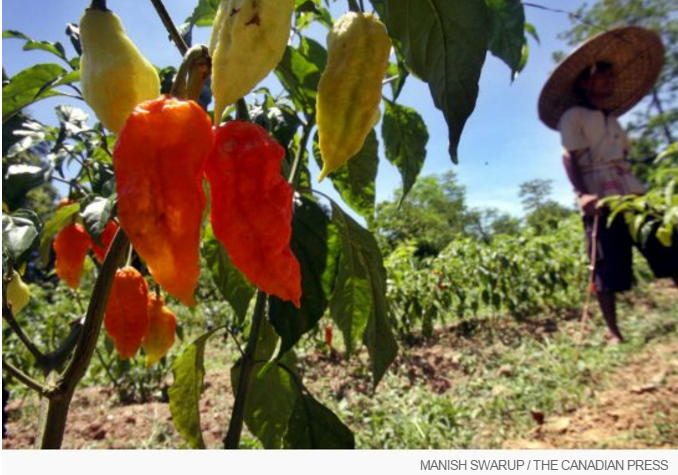Without a crystal ball at the kitchen table, predicting what foodies will be clamouring for in the future is never a simple task. The Star has boiled down the buffet of food trend forecasts to declare these eight ingredients the ones to eat in 2016. Pull out your grocery app and get ahead of the curve.
Ghost peppers
Blame what food and consulting firm Technomic has called “the sriracha effect” on the rise of ghost peppers. Clocking in at one million Scoville heat units — hundreds of times hotter than a jalapeno — it’s one of the world’s most fiery chili peppers (certified by Guinness World Records as the hottest in 2007, but later surpassed by other breeds, such as the Carolina Reaper). This Indian pepper is also part of a growing craze for Indian cuisine, particularly Indian street food such as kathi rolls (roasted kebab wrapped in roti flatbread).
Also look for: East Asian shishito peppers.
The United Nations has declared 2016 the International Year of Pulses. While Toronto has been eating these edible seeds and grains (think dried peas, edible beans, lentils and chickpeas) for a while now, expect to see them in more dishes than ever with the UN stamp of approval. They’re not just good for sustainable farming in regions such as Latin America, Africa and Asia; they’re low in fat and high in protein and fibre for everyone. Spices and flavouring company McCormick & Company suggest pigeon peas, cranberry beans and black beluga lentils could be the new go-to pulses in the coming months.
Freekeh

Freekeh is an ancient grain and superfood expected to explode in 2016. Aroma Espresso Bar added a “freekeh salad” to their menu summer 2015.
With quinoa on the outs, look for freekeh (pronounced freak-ah) a roasted green wheat grain to surge in 2016. It has already been spotted on some Toronto menus: Aroma Espresso Bar added a freekeh salad this summer.
Also look for: the nutty and earthy flavour of amaranth, which you can even pop like popcorn on a stovetop, suggests McCormick executive chef Kevan Vetter. “Chefs are looking backwards with some of these ingredients,” he says, “but pulling them into the future.”
African flavours

RENE JOHNSTON
Expect to see more African pastes such as Morocco’s harissa in 2016.
Restaurants will serve up more and more African flavour in the new year, continuing the trendy zest for heat. Popular U.K. peri-peri chain Nando’s continued to expand across the GTA in 2015. Expect to see more African pastes such as Morocco’s harissa on menus and condiments such as Egypt’s dukka. From North Africa, sumac will continue painting the foodie scene even redder. And Toronto’s Ethiopian cuisine could get the attention it deserves with berbere spice blends going mainstream.
Fried chicken

ANDREW SCRIVANI
Fried chicken is already huge — expect it to get even bigger in 2016.
Fried chicken is already huge. Expect it to get even bigger on waffles, in sandwiches, or plain in a paper sleeve. Among the recently opened Toronto spots specializing in fried chicken are Kensington’s The Dirty Bird, Cluck Clucks on The Esplanade, and Taiwanese chain Hot-Star Large Fried Chicken on Yonge St. near Gerrard St. (the first North American location). FC of all kinds is a trend that won’t die.
Gochujang

Gochujang is a fermented paste traditionally made from red chili, glutinous rice, soybeans and salt.
The “sriracha effect” will be in full force in 2016, with condiments such as Korean pepper paste gochujang getting their time to shine. As ubiquitous in Korea as ketchup in Canada, gochujang is a fermented paste traditionally made from red chili, glutinous rice, soybeans and salt. Squirt it onto your scrambled eggs, use it as a marinade, or mix it into dipping sauces.
Also look for: Sambal sauce. McCormick executive chef Kevan Vetter says the sauce, made with chilies, rice vinegar and garlic, could conquer with its combination of tang and heat.
Zucchini

Zucchini might see the spotlight in 2016
This squash might see the spotlight in 2016 with vegetables at the centre of the restaurant experience. Taavo Kuutan of King West’s Weslodge, where they recently added fried zucchini to the menu, says it could be the new asparagus. Toronto dietitian Abbey Sharp, too, has seen more recipes than ever for zucchini in the past six months. “Before, zucchinis were for making zucchini bread,” she says. Now you can expect theight see the spotlight in 2016.m to take all forms — even noodles. Break out your spiralizer and spin out some zucchini pasta.
Hawaiian poke

NICK KOZAK
Popular Hawaiian appetizer poke (pronounced poke-eh or poke-ee and meaning “to slice or cut”) is trending on many menus across North America.
Though we’re more than 7,000 kilometres away from this island, Toronto might be saying “aloha” more at the table in 2016. Popular Hawaiian appetizer poke (pronounced poke-eh or poke-ee and meaning “to slice or cut”) is trending on many menus across North America. International food and restaurant consultants Baum and Whiteman predict it could be the next ceviche. The raw fish dish is typically made with ahi tuna (yellowfin tuna), but can also be made with salmon or octopus.
Read the full post in Toronto Star Food & Wine


Leave a Reply